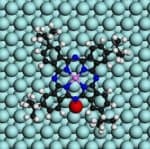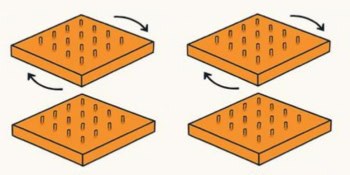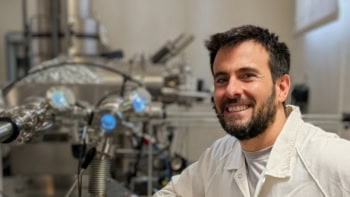
Researchers in China and the UK have made a new type of nanometre-sized rotor with an off-centre axis of rotation. The researchers have also made arrays of the devices that spread over distances as large as micrometres.
The individual rotors in the arrays work in concert, something that the team believes will be crucial for making molecular machines. Such machines could be used as tiny autonomous “nanorobots” in the future that would perform a wide range of tasks, such as assembling electronic circuits or delivering drugs to specific parts of the body.
Easier to control
Although physicists have been able to make molecular rotors, previous devices had no fixed axis and were thus not easy to control, which made it difficult to integrate them into real working devices. Using scanning tunnelling microscopy, Hongjun Gao and colleagues of the University of Liverpool, UK, and the Chinese Academy of Sciences have now shown that single tetra-tert-butyl zinc phthalocyanine molecules on gold surfaces have a well-defined rotation axis fixed on the surface (Phys. Rev. Lett. 101 197209). “The result is an important milestone in making practical single molecule devices,” Gao told physicsworld.com.
The researchers made the device by evaporating molecules of tetra-tert-butyl zinc phthalocyanine onto a gold crystal. The molecules adsorb by attaching to a single gold atom off centre, at the position of nitrogen molecules on the zinc phthalocyanine.
Thermal excitation
The device works using thermal excitation — the molecules are not in their ground state and so rotate. The fact that the centre of rotation is at the edge of the device and not at its molecular centre means that it acts like a wheel with an axle attached at the perimeter, explained Gao. “We can therefore also excite rotations by means other than heat, such as electron transport through the molecule from its gold attachment,” he said.
The device might also be rotated by placing a magnetic atom at the molecular centre. In this way, current travelling through the molecule from the gold lead would interact with the magnetic moment at the centre, and the magnitude of the current used to determine rotation velocity. “Now we have a rotating magnetic field — a key component of a generator,” explained Gao.
Back in the lab, the team is currently trying to create arrays with magnetic atoms at the centre. The researchers are also trying to change the rotation direction of their rotors with current flow.



